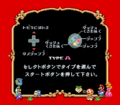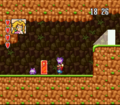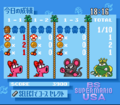BS Super Mario USA: Difference between revisions
(wart can be battled E V E R Y W H E R E !) |
mNo edit summary |
||
| Line 18: | Line 18: | ||
}} | }} | ||
'''''BS Super Mario USA''''' is a remake (pseudo-sequel) | '''''BS Super Mario USA''''' is a remake of (pseudo-sequel to) ''[[Super Mario Bros. 2|Super Mario USA]]'' (which is based on the American version of ''[[Super Mario Bros. 2]]'') for the [[Satellaview]], an add-on for the [[SNES|Super Famicom]]. It was the first ''[[Mario (series)|Mario]]'' platformer game to make use of the Satellaview's Soundlink features. | ||
==General Info== | ==General Info== | ||
The gameplay is essentially the same as the SNES version of ''Super Mario Bros. 2''. | The gameplay is essentially the same as the SNES version of ''Super Mario Bros. 2''. | ||
The game was released in four | The game was released in four instalments. In each one, the play was sent to a different ''SMB2'' "World". The goal was seemingly to collect the Gold Mario Statues located in each level, defeat the [[boss]], and then find and beat [[Wart]], that can be battled in any when going down in any tube, while the player is in [[Subspace]]. The player could select the levels in any order and return to the levels as often as desired until the "episode" ended at around 50 minutes on the clock. | ||
As the gameplay episode progressed, an audio drama would stream via St. Giga's Satellite radio, which would tell the narrative of the story. | As the gameplay episode progressed, an audio drama would stream via St. Giga's Satellite radio, which would tell the narrative of the story. | ||
| Line 36: | Line 36: | ||
*The game has a built-in clock (meant to be in sync with real-time) that has the game start at around :05 minutes in and end at around :50 minutes in. | *The game has a built-in clock (meant to be in sync with real-time) that has the game start at around :05 minutes in and end at around :50 minutes in. | ||
*The [[player]] starts the game off as [[Mario]]. Character changing is forcibly done in timed events. | *The [[player]] starts the game off as [[Mario]]. Character changing is forcibly done in timed events. | ||
*An interesting new feature is the addition [[Mario Statue]]s. Picking up one of these gives Mario an extra life and fills his life meter. There are three of these in each level, plus one obtainable from the end-of-the-world | *An interesting new feature is the addition [[Mario Statue]]s. Picking up one of these gives Mario an extra life and fills his life meter. There are three of these in each level, plus one obtainable from the end-of-the-world boss. They are usually out in the open, but sometimes are hidden in [[Subspace]]. Levels can be played over again in order to obtain all of the statues. It is unknown whether there is a reward for collecting them all. | ||
*[[Coins]] were added to levels. | *[[Coins]] were added to levels. | ||
*The "Today's Results Screen" temporarily records the [[Mushrooms]], [[Cherries]], Coins, Mario Statues, defeated bosses, and current level. | *The "Today's Results Screen" temporarily records the [[Mushrooms]], [[Cherries]], Coins, Mario Statues, defeated bosses, and current level. | ||
*A points system was added. | *A [[points]] system was added. Points can be gained, among other things, by defeating [[enemies]] in various ways. | ||
*Key sequences in the narrative are accompanied by events that occur in-game. The most common of these are the character portraits at the top of the screen which show which character is talking. Other events may include powerups, power-downs, obstacle-spawnings, or the revealing of secrets. | *Key sequences in the narrative are accompanied by events that occur in-game. The most common of these are the character portraits at the top of the screen which show which character is talking. Other events may include powerups, power-downs, obstacle-spawnings, or the revealing of secrets. | ||
Revision as of 15:19, November 16, 2010
BS Super Mario USA is a remake of (pseudo-sequel to) Super Mario USA (which is based on the American version of Super Mario Bros. 2) for the Satellaview, an add-on for the Super Famicom. It was the first Mario platformer game to make use of the Satellaview's Soundlink features.
General Info
The gameplay is essentially the same as the SNES version of Super Mario Bros. 2.
The game was released in four instalments. In each one, the play was sent to a different SMB2 "World". The goal was seemingly to collect the Gold Mario Statues located in each level, defeat the boss, and then find and beat Wart, that can be battled in any when going down in any tube, while the player is in Subspace. The player could select the levels in any order and return to the levels as often as desired until the "episode" ended at around 50 minutes on the clock.
As the gameplay episode progressed, an audio drama would stream via St. Giga's Satellite radio, which would tell the narrative of the story.
Plot outline
Template:Sectionstub The plotline seems to take place after the original Super Mario USA.
The King of Subcon placed Gold Statues of Mario around his kingdom as thanks for the previous time he defeated Wart. However, the Birdo trio, Mouser, Tryclyde, Fryguy and Clawgrip are apparently stealing them.
Differences/Additions
- The game has a built-in clock (meant to be in sync with real-time) that has the game start at around :05 minutes in and end at around :50 minutes in.
- The player starts the game off as Mario. Character changing is forcibly done in timed events.
- An interesting new feature is the addition Mario Statues. Picking up one of these gives Mario an extra life and fills his life meter. There are three of these in each level, plus one obtainable from the end-of-the-world boss. They are usually out in the open, but sometimes are hidden in Subspace. Levels can be played over again in order to obtain all of the statues. It is unknown whether there is a reward for collecting them all.
- Coins were added to levels.
- The "Today's Results Screen" temporarily records the Mushrooms, Cherries, Coins, Mario Statues, defeated bosses, and current level.
- A points system was added. Points can be gained, among other things, by defeating enemies in various ways.
- Key sequences in the narrative are accompanied by events that occur in-game. The most common of these are the character portraits at the top of the screen which show which character is talking. Other events may include powerups, power-downs, obstacle-spawnings, or the revealing of secrets.
Gameplay screens
Release info
Being episodic, BS Super Mario USA was released on a weekly basis.
The four episodes were premiered during these weeks: [1]
| Date/Date Range | Japanese | Rōmaji | Translation |
|---|---|---|---|
| 1996/03/31~1996/04/05 | BSスーパーマリオUSA パワーチャレンジ 第1回 「あたしたち、スーパーキャサリンズ」の巻 | BS Super Mario USA Power Challenge Dai-1-kai "Atashitachi, Super-Katherines!" no Kan | BS Super Mario USA Power Challenge Episode 1 Volume of "We, the Super-Birdos!" |
| 1996/04/07~1996/04/12 | BSスーパーマリオUSA パワーチャレンジ 第2回 「ガブチョもびっくり流砂の秘密」の巻 | BS Super Mario USA Power Challenge Dai-2-kai "Gabucho mo Bikkuri Ryuusha no Himitsu" no Kan | BS Super Mario USA Power Challenge Episode 2 Volume of "Tryclyde also surprises, Secrets of the Quicksand" |
| 1996/04/14~1996/04/19 | BSスーパーマリオUSA パワーチャレンジ 第3回 「氷の海でヒーボーボー」の巻 | BS Super Mario USA Power Challenge Dai-3-kai "Kouri no Umi de Hībōbō" no Kan | BS Super Mario USA Power Challenge Episode 3 Volume of "Fry Guy at the Sea of Ice" |
| 1996/04/21~1996/04/26 | BSスーパーマリオUSA パワーチャレンジ 第4回 「マムーの罠,危うしマリオブラザーズ」の巻 | BS Super Mario USA Power Challenge Dai-4-kai "Mamū no Wana. Kyushi Super Mario Brothers" no Kan" | BS Super Mario USA Power Challenge Episode 4 Volume of "Wart's Trap. Danger, Super Mario Bros." |
The timeframe in which these episodes were featured was likely 7PM. They were rebroadcast multiple times, but as a full schedule of releases for the Satellaview is not available it is uncertain exactly how many.
Music
The Satellaview's Soundlink-capabilities allowed music to be streamed via Satellite radio. This game used this to enhance it's soundtrack with songs that could not be performed via the Super Famicom's soundchips.
As the game played, music from the Super Mario World Soundtrack and Super Mario Bros. 1, 2, 3, Hop! Step! Jump! - as well as new, original compositions and jingles - would be used in place of the traditional Super Mario USA music. Surprisingly, none of the music is actually remixed or arranged from the original Super Mario USA.
Cameos
- In "Satellawalker 2 - Sate Bou wo Sukuedase!", BS Super Mario USA's Event Plaza, the giant Birdo tower, is one of the decaying Event Plaza buildings hidden under the lake.
External links
Footage of game recordings from actual broadcasts. These show how the game plays and the audio drama that accompanies it.


